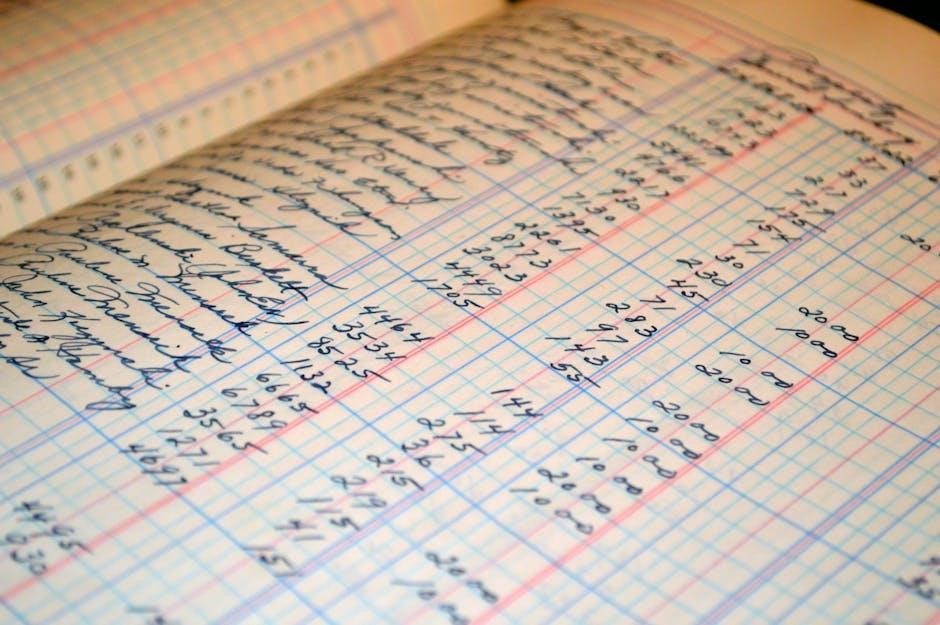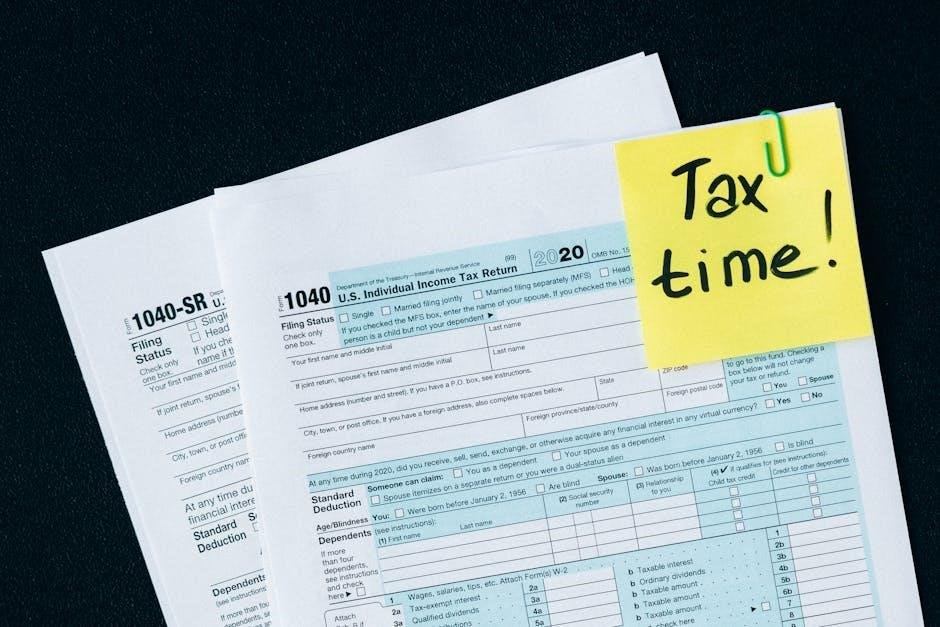
Rational numbers are fundamental in mathematics, representing any number expressible as a fraction of two integers. They include integers, finite decimals, and repeating decimals, essential for various mathematical operations.
1.1 Definition of Rational Numbers
A rational number is any number that can be expressed as the ratio of two integers, where the denominator is not zero. This includes integers, fractions, terminating decimals, and repeating decimals. For example, numbers like 1/2, 3, or 0.5 are rational. The key characteristic is that they can be written in the form a/b, where a and b are integers, and b ≠ 0. This definition encompasses all finite and repeating decimal values.
1.2 Importance of Rational Numbers in Mathematics
Rational numbers are foundational in mathematics, serving as the basis for understanding fractions, decimals, and their operations. They are essential for solving real-world problems, such as measurements, finance, and science. Mastery of rational numbers simplifies advanced math concepts like algebra and calculus. Their ability to represent exact values makes them crucial for precise calculations. Additionally, they enable comparisons and ordering, which are vital skills in data analysis and problem-solving.
Characteristics of Rational Numbers
Rational numbers are integers or fractions, with terminating or repeating decimals, distinguishable from irrationals, and essential for precise mathematical operations and real-world applications.
2.1 Representation as Fractions
Rational numbers are uniquely represented as fractions where a numerator and denominator are integers. This form allows for easy identification and manipulation in mathematical operations, ensuring clarity and precision. Fractions can be simplified to their lowest terms, making them invaluable in solving equations and comparing values. This representation is foundational across various mathematical disciplines and real-world applications.
2.2 Terminating and Repeating Decimal Expansions
Rational numbers can be expressed as terminating or repeating decimals. Terminating decimals, like 0.5 or 0.25, end after a finite number of digits. Repeating decimals, such as 0.333… or 0.1666…, have patterns that repeat infinitely. These decimal forms are directly linked to their fractional representations, making them essential for understanding and working with rational numbers in various mathematical operations and real-world applications.

Operations with Rational Numbers
Performing operations with rational numbers involves addition, subtraction, multiplication, and division. These operations follow specific rules to ensure accuracy. Worksheets provide structured exercises to practice these skills, enhancing mathematical fluency and problem-solving abilities. Mastering operations with rational numbers is crucial for advanced mathematical concepts and real-world applications. Regular practice through worksheets helps build confidence and understanding of these fundamental operations.
3.1 Addition and Subtraction of Rational Numbers
Addition and subtraction of rational numbers involve finding a common denominator when the fractions are unlike. For example, to add ( rac{1}{2} + rac{1}{3} ), convert them to ( rac{3}{6} ) and ( rac{2}{6} ), resulting in ( rac{5}{6} ). Subtracting rational numbers follows a similar process. These operations are foundational for solving equations and word problems. Worksheets provide exercises to practice these skills, ensuring mastery of rational number arithmetic. Regular practice enhances mathematical fluency and accuracy.
3;2 Multiplication and Division of Rational Numbers
Multiplying rational numbers involves multiplying numerators and denominators separately, while division requires multiplying by the reciprocal. For example, (1/2) ÷ (1/3) = (1/2) * (3/1) = 3/2. These operations are crucial for solving algebraic expressions and real-world problems. Worksheets often include exercises to practice these skills, ensuring understanding of fraction arithmetic and application in various scenarios. Regular practice helps build confidence and mastery of rational number operations.

Comparing Rational Numbers
Comparing rational numbers involves using inequality symbols to determine their relationships. Numbers can be ordered on a number line, with fractions and decimals easily compared for accuracy.
4.1 Using Inequality Symbols
Inequality symbols are essential for comparing rational numbers. They include <, >, ≤, and ≥. These symbols help determine relationships between numbers, such as which is smaller or larger. When working with positive and negative rational numbers, the symbols indicate magnitude. For example, -3 < 2 and 5 > 4.2. Using inequalities, students can solve equations and word problems effectively. Understanding inequalities is crucial for advanced math concepts.
4.2 Ordering Rational Numbers on a Number Line
Ordering rational numbers on a number line involves placing them from left to right, with smaller numbers on the left and larger on the right. This applies to both positive and negative rational numbers. To compare fractions or decimals, convert them to a common denominator or decimal form. For example, 1/2 (0.5) is less than 3/4 (0.75). Ordering exercises help students understand number relationships and prepare them for more complex math concepts.

Word Problems Involving Rational Numbers
Word problems involving rational numbers often relate to real-life scenarios, such as calculating distances, budgeting money, or adjusting recipe measurements. They require converting between fractions and decimals to find practical solutions.
5.1 Solving Real-World Scenarios
Solving real-world scenarios involving rational numbers is essential for practical applications. These problems often require converting between fractions and decimals to calculate measurements, such as dividing resources equally or scaling recipes. For example, determining the cost of materials for a project or adjusting ingredients for a larger group involves rational numbers. Word problems in finance, like calculating interest rates or budgeting expenses, also rely heavily on rational number operations. These scenarios help develop problem-solving skills and real-world applicability of mathematical concepts.
5.2 Interpreting Word Problems
Interpreting word problems requires translating real-world situations into mathematical expressions using rational numbers. This involves identifying key information, such as quantities, operations, and relationships. For instance, problems might involve mixing solutions, calculating speeds, or determining prices. By breaking down the language and converting it into equations, students can solve practical challenges effectively. Practice worksheets help refine these skills, ensuring accurate interpretation and application of rational numbers in diverse contexts.

Types of Rational Numbers Worksheets
Rational numbers worksheets include exercises on equivalent fractions, standard form conversions, and word problems. These activities help students understand and master key concepts effectively.
6.1 Equivalent Rational Numbers
Equivalent rational numbers are fractions or decimals that represent the same value despite different representations. Worksheets on this topic help students identify, create, and simplify equivalent fractions. Activities include matching equivalent decimals to fractions, completing number lines, and solving word problems. These exercises enhance understanding of fraction properties and their real-world applications, such as measurements or financial calculations.
6.2 Standard Form Conversions
Standard form conversions involve expressing rational numbers in their simplest integer or fractional form. Worksheets focus on converting decimals to fractions and ensuring proper formatting. For example, 0.5 becomes 1/2, and 2.75 becomes 11/4. These exercises help students master simplification and mixed number conversions, essential for solving equations and word problems. Practice includes identifying equivalent fractions and applying these skills to real-world scenarios, enhancing problem-solving abilities.

Decimal and Fraction Conversions
Convert fractions to decimals by dividing the numerator by the denominator. For example, 1/2 becomes 0.5, and 0.5 becomes 1/2. Practice these essential skills.
7.1 Converting Fractions to Decimals
Converting fractions to decimals involves dividing the numerator by the denominator. For example, 1/2 becomes 0.5, and 3/4 becomes 0.75. If the division results in a repeating or terminating decimal, it confirms the number is rational. Practice this skill to enhance understanding of rational numbers and their decimal representations. Worksheets provide exercises to master this conversion process effectively.
7.2 Converting Decimals to Fractions
Converting decimals to fractions is straightforward for rational numbers. For terminating decimals, place the decimal over 1, then remove the decimal point and simplify. For repeating decimals, use a bar to denote repetition, then solve an equation to find the fraction. For example, 0.5 becomes 1/2, and 0.333… becomes 1/3. Ensure fractions are in simplest form for accuracy. Worksheets provide ample practice for mastering this essential skill.

Properties of Rational Numbers
Rational numbers exhibit commutative and associative properties under addition and multiplication. They also support distributive property, ensuring predictable outcomes in arithmetic operations, essential for solving mathematical problems accurately.
8.1 Commutative and Associative Properties
The commutative property states that the order of numbers does not affect the result. For addition: a + b = b + a; for multiplication: a * b = b * a. The associative property holds that the grouping of numbers does not change the outcome. For addition: (a + b) + c = a + (b + c); for multiplication: (a * b) * c = a * (b * c). These properties simplify calculations and are fundamental in algebraic manipulations, ensuring consistency and reliability in solving equations and expressions. They apply universally to all rational numbers, making them foundational tools in mathematics, particularly in problem-solving and theorem development.
8.2 Distributive Property
The distributive property combines multiplication and addition, stating that a(b + c) = ab + ac. This property applies to rational numbers, allowing the distribution of multiplication over addition or subtraction. It simplifies expressions and equations, enabling easier calculations. For example, 3(2/3 + 1/3) = 3*(1) = 3. This property is essential for solving algebraic problems and simplifying complex expressions involving rational numbers, ensuring accurate and efficient solutions in mathematical operations.
Placing Rational Numbers on a Number Line
Rational numbers can be placed on a number line, identifying their positions between integers. This visual representation aids in understanding their relationships and comparisons effectively.
9.1 Identifying Positions
Identifying positions of rational numbers on a number line involves marking their exact locations between integers. This process enhances understanding of their magnitude and relationships. By plotting fractions and decimals, students visualize numerical order and proximity. Such exercises are essential for comparing values and recognizing intervals between numbers. Worksheets often include activities where learners label and arrange rational numbers, improving their spatial reasoning and mathematical comprehension. This skill is foundational for advanced number line concepts and real-world applications.
9.2 Understanding Density of Rational Numbers
Rational numbers are densely packed on the number line, meaning between any two rationals, infinitely many others exist. This property highlights their abundance and lack of gaps. Worksheets often include exercises where students identify multiple rational numbers between two given fractions, reinforcing the concept of density. This understanding is crucial for grasping advanced mathematical ideas and appreciating the intricate structure of rational numbers in real number systems.

Assessing Understanding
Assess understanding with quizzes, tests, and practice exercises. Utilize Kuta Software worksheets for operations and word problems, ensuring mastery of rational numbers concepts and applications.
10.1 Worksheets for Practice
Worksheets are essential for mastering rational numbers. They cover topics like equivalent fractions, standard form, and operations. Fill-in-the-blank and multiple-choice formats cater to different learning styles. Word problems and number line activities enhance understanding. Worksheets vary in difficulty, from basic operations to advanced applications. Regular practice with these resources builds confidence and fluency in handling rational numbers. They are ideal for homework or self-study, ensuring comprehensive skill development.
- Covers addition, subtraction, multiplication, and division
- Includes word problems and real-world scenarios
- Features number line and decimal conversion exercises
- Available in multiple difficulty levels
10.2 Quizzes and Tests
Quizzes and tests are crucial for assessing understanding of rational numbers. They include multiple-choice questions, fill-in-the-blanks, and problem-solving exercises. Timed tests help improve speed and accuracy. Detailed answer keys provide feedback for self-assessment. These resources ensure mastery of concepts like operations, conversions, and word problems. Regular testing reinforces learning and identifies areas for improvement. They are ideal for classroom or independent use, offering a comprehensive evaluation of rational number skills.
- Includes timed assessments for better preparation
- Contains detailed answer keys for feedback
- Covers a wide range of topics and difficulty levels
- Helps track progress and identify weak areas

Common Misconceptions
A common misconception is that all fractions are simple, but complex fractions can be challenging. Some confuse rational numbers with irrationals, like Pi, which cannot be expressed as fractions.
11.1 Differences from Irrational Numbers
Rational numbers can be expressed as fractions of two integers, unlike irrational numbers, which cannot. For example, π and √2 are irrational, as their decimal expansions are non-repeating and non-terminating. Rational numbers, such as 1/2 or 3.75, have terminating or repeating decimals. This fundamental difference impacts their properties and uses in mathematics. Understanding this distinction is crucial for solving problems involving both rational and irrational numbers effectively.
11.2 Avoiding Errors in Operations
Common errors in rational number operations include improper fraction simplification and decimal conversion mistakes. Ensuring denominators are non-zero and accurately handling negative signs are critical. Double-checking arithmetic steps and fraction reductions helps prevent errors. Practicing with worksheets and reviewing concepts regularly can enhance accuracy. Understanding these pitfalls aids in mastering rational number operations effectively.

Advanced Topics
Advanced topics in rational numbers explore sophisticated concepts like identifying intermediate rationals and simplifying complex fractions, enhancing mathematical reasoning and problem-solving skills.
12.1 Finding Rational Numbers Between Two Fractions
Finding rational numbers between two fractions involves identifying values that lie within the range. For example, between 1/8 and 2/9, you can find 3/24 or 5/40. These numbers are found by converting the fractions to a common denominator or adjusting the numerator and denominator appropriately. This skill enhances understanding of number density and prepares for advanced mathematical operations. Regular practice with worksheets helps master the concept effectively.
12.2 Simplifying Complex Fractions
Simplifying complex fractions involves reducing them to their lowest terms. For example, to simplify ( rac{1/2 + 1/3}{2/3 ⎻ 1/4} ), find common denominators for the numerator and denominator separately. Convert each fraction, add or subtract, and then divide. This process ensures the fraction is in its simplest form. Worksheets provide numerous exercises to practice this skill, helping to master the concept of complex fraction simplification effectively.
Resources for Further Learning
Recommended worksheets and online tools provide comprehensive practice and understanding of rational numbers. Utilize tutorials and guides to enhance your skills and knowledge effectively.
13.1 Recommended Worksheets
Enhance your understanding with curated worksheets designed to cover various aspects of rational numbers. These include equivalent fractions, standard form conversions, and operations like addition and subtraction. Practice with word problems and number line activities to improve comprehension. Additionally, compare and order rational numbers, and convert between decimals and fractions. These resources are ideal for students seeking thorough practice and mastery of rational number concepts, ensuring a solid foundation for advanced topics.
13.2 Online Tools and Tutorials
Supplement your learning with online tools and tutorials designed to enhance your grasp of rational numbers. Platforms like Khan Academy and Mathway offer interactive exercises and video tutorials. Tools such as GeoGebra provide visual representations for concepts like number lines and fraction conversions. Additionally, websites like Symbolab allow real-time problem solving, helping you understand operations and conversions. These resources cater to diverse learning styles, ensuring a comprehensive understanding of rational numbers and their applications.